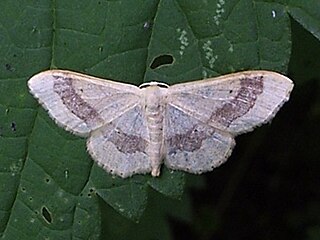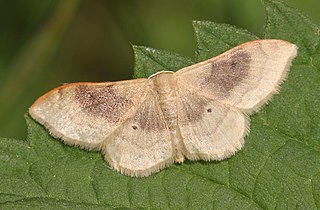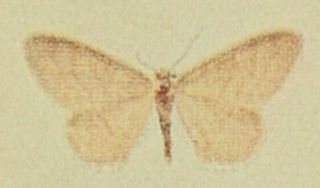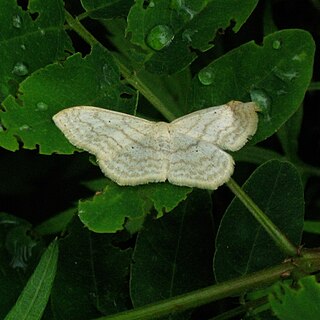
The geometer moths are moths belonging to the family Geometridae of the insect order Lepidoptera, the moths and butterflies. Their scientific name derives from the Ancient Greek geo γεω, and metron μέτρον "measure" in reference to the way their larvae, or inchworms, appear to measure the earth as they move along in a looping fashion. A very large family, it has around 23,000 species of moths described, and over 1400 species from six subfamilies indigenous to North America alone. A well-known member is the peppered moth, Biston betularia, which has been subject of numerous studies in population genetics. Several other geometer moths are notorious pests.

The small fan-footed wave is a moth of the family Geometridae. The species was first described by Johann Siegfried Hufnagel in 1767.

The small dusty wave is a moth of the family Geometridae first described by Franz von Paula Schrank in 1802. It is found throughout Western, Central and Northern Europe. In the north, its range extends as far as Denmark and southern Scandinavia. In the east its range extends as far as Russia. Idaea seriata is replaced by the subspecies Idaea seriata canteneraria, from the north-east of Spain and the central and eastern Mediterranean to the Crimean peninsula, while the western Mediterranean and the Balearic Islands are inhabited by the sister species Idaea minuscularia. Outside Europe it is found in eastern Algeria, Tunisia, Turkey, Cyprus, the Caucasus and the northwest of Transcaucasia. In Morocco and western Algeria, it is replaced by the sister species Idaea minuscularia. In the British Isles it is common in England and Wales but is only found in the eastern half of Scotland and it is rare in Ireland.

The riband wave is a moth of the family Geometridae. The species was first described by Carl Linnaeus in his 1758 10th edition of Systema Naturae.

Idaea, sometimes called Hyriogona, is a large genus of geometer moths. It was erected by Georg Friedrich Treitschke in 1825. They are found nearly worldwide, with many native to the Mediterranean, the African savannas, and the deserts of western Asia.

Idaea dimidiata, the single-dotted wave, is a moth of the family Geometridae. It is a Holarctic species.

Idaea ochrata, the bright wave, is a moth of the family Geometridae. It is found in Europe.

Idaea fuscovenosa, the dwarf cream wave, is a moth of the family Geometridae. It is found in the Palearctic,

Idaea straminata, the plain wave, is a moth of the family Geometridae. It is found in Europe including West Russia and Balkans.

Idaea degeneraria, the Portland ribbon wave, is a moth of the family Geometridae. The species was first described by Jacob Hübner in 1799.

Idaea contiguaria, the Weaver's wave, is a moth of the family Geometridae. It was first described by Jacob Hübner in 1799 and is found in Europe.

Idaea humiliata, the Isle of Wight wave, is a moth of the family Geometridae. It is found in Europe and Western Asia.

Idaea dilutaria, also called the silky wave, is a moth of the family Geometridae. It is found in Europe.

Idaea sylvestraria, the dotted border wave, is a moth of the family Geometridae. The species was first described by Jacob Hübner in 1799. It is found in Europe.

Idaea laevigata, the strange wave, is a moth of the family Geometridae. It is found in Central Europe and Southern Europe. It occurs in Britain as an imported species.

Idaea serpentata, the ochraceous wave, is a moth of the family Geometridae. The species was first described by Johann Siegfried Hufnagel in 1767. It is found in most of continental Europe and the Near East.

Scopula rubiginata, the tawny wave, is a moth of the family Geometridae. The species was first described by Johann Siegfried Hufnagel in 1767.

Idaea tacturata, the dot-lined wave moth, is a moth of the family Geometridae. The species was first described by Francis Walker in 1861. It is found in the US from Virginia to Florida, west to south-eastern coastal Texas.

Idaea furciferata, the notch-winged wave moth, is a moth in the family Geometridae. It is found in North America, where it has been recorded from Maryland to northern Florida, west to Missouri and Texas.


















